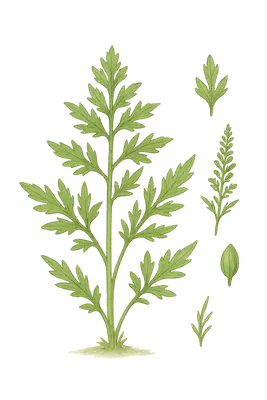Mugwort (Weed)
Description
Mugwort (Artemisia vulgaris) is a perennial herbaceous plant belonging to the Asteraceae family. It is commonly found in temperate regions across Europe, Asia, and North America, thriving in waste areas, roadsides, and fields. The plant can grow between 1.5 to 8 feet tall, featuring gray-green, elliptical leaves that are often lobed at the tips. Mugwort is known for its aromatic properties and has been used traditionally in herbal medicine.

Allergy Symptoms
Exposure to mugwort pollen can trigger various allergic reactions, including:
- Nasal symptoms: Sneezing, runny or congested nose.
- Ocular symptoms: Itchy, watery, and red eyes.
- Respiratory issues: Coughing and exacerbation of asthma symptoms.
- Oral Allergy Syndrome (OAS): Itchy mouth or throat after consuming certain foods due to cross-reactivity.
Mugwort pollen contains PR-1 proteins, which are associated with OAS. Individuals allergic to mugwort may experience symptoms after ingesting related plant foods such as vegetables, fruits, and nuts.
Typical Pollination Period
Mugwort typically pollinates from late summer to early autumn:
- United States: July to October, with peak levels in September.
- Europe: June to September, varying by region.
Geographic Distribution
Mugwort is widely distributed across:
- Europe: Common throughout, especially in Northern and Southern regions.
- Asia: Found in various parts, including China and Japan.
- North America: Present in the western United States, including California, Idaho, Nevada, Oregon, and Washington.
Tips for Reducing Exposure and Managing Allergies
- Monitor pollen forecasts: Stay updated on local mugwort pollen levels during the pollination season.
- Limit outdoor activities: Especially on high pollen count days and during windy conditions.
- Protect indoor environments: Keep windows closed and use air purifiers to reduce indoor pollen exposure.
- Personal hygiene: Shower and change clothes after being outdoors to remove pollen.
- Dietary considerations: Be cautious with foods that may cross-react with mugwort pollen, such as certain fruits, vegetables, and spices.
- Medication: Use antihistamines, nasal corticosteroids, or other allergy medications as recommended by a healthcare professional.
- Consult an allergist: For persistent or severe symptoms, seek advice from an allergist who may recommend immunotherapy or other treatments.